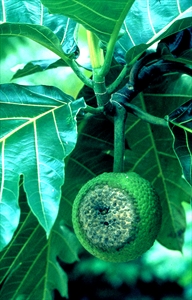Breadfruit rot
Pacific Pests, Pathogens, Weeds & Pesticides - Online edition
Pacific Pests, Pathogens, Weeds & Pesticides
Breadfruit Phytophthora fruit rot (130)
Phytophthora palmivora
Asia, Africa, North, South and Central America, Europe, Oceania. It is recorded from American Samoa, Australia, Federated States of Micronesia, Fiji, French Polynesia, New Caledonia, Northern Mariana Islands, Palau, Papua New Guinea, Samoa, Solomon Islands, Tonga, and Vanuatu. Commonly, it occurs on cocoa, coconut and papaya. Only in American Samoa, Federated States of Micronesia, and Samoa has it been recorded from breadfruit.
It is recorded from Samoa (breadfruit, cocoa and coconut); Fiji (cocoa, coconut, papaya, rubber); Solomon Islands (cocoa, coconut); and Tonga (coconut).
Phytophthora is not a fungus, although much of its biology and life cycle is fungus-like. It is a water mould or an oomycete, related to algae.
The disease on breadfruit usually starts on the lower fruit; this is because heavy rain splashes soil up to a metre above ground level, and soil can contain spores of the water mould. Infection of the fruit causes a brown spot at first, which turns white as it becomes covered with growth of the mould. Spores are formed in this growth. After a few more days, when the spot has grown to about 8-10 cm, the fruit is completely rotten and falls off the tree.
The disease spreads when spores are moved from the spots in wind-driven rain. The spores - called sporangia (a single one is a sporangium) - do not germinate directly; most often they form small swimming spores called zoospores that travel in the water on the fruit surface or wherever they land. There are about 20 zoospores in each sporangium. After a short swim, the zoospores stop moving, germinate and infect the fruit. Fruits can have more than one infection.
On breadfruit, it is only the fruit that is affected (Photo 1), not the leaves or the branches. The disease is not common in Samoa, although in times of prolonged wet weather it can cause large losses on certain varieties. The disease often starts on the lower fruit, and then, depending on the weather and the maturity of the other fruit, spreads to the rest of the fruit. About one week after infection the rotten fruit fall off the tree.
Look for the cottony white growth on the side of the fruit, or perhaps at the bottom. Cut the fruit open to see the brown rot inside. The lemon-shaped spores can be seen with the use of a x10 hand lens.
CULTURAL CONTROL
- Prune low branches to avoid soil containing Phytophthora spores splashing onto fruit during heavy rains.
- Remove infected lower fruit from the tree to stop spread to fruit higher in the canopy.
- Prune breadfruit by 'topping' the trees so that: (i) fruit are easier to reach; (ii) air circulates through the trees drying the surface of the fruit; (iii) fruit with rots are easier to remove; (iv) water containing spores do not drip onto fruit below and infect them. Note, topping is best done when the trees are young by removal of the leading shoot, and annually after fruiting. Keep the height of the tree to 3-4 metres.
- Mulch the soil under the trees to prevent soil containing spores from reaching low-hanging fruit.
RESISTANT VARIETIES
In Samoa, the variety Puou is said to be more susceptible.
CHEMICAL CONTROL
It is unlikely that chemicals would be used against Phytophthora fruit rot, but if they were, perhaps on fruit that is sold on domestic or export markets, protectant fungicides containing copper or mancozeb would be suitable, or systemic products, e.g., metalaxyl, potassium phosphonate or fosetyl-aluminium.
____________________
When using a pesticide, always wear protective clothing and follow the instructions on the product label, such as dosage, timing of application, and pre-harvest interval. Recommendations will vary with the crop and system of cultivation. Expert advice on the most appropriate pesticides to use should always be sought from local agricultural authorities.
AUTHOR Grahame Jackson
Information from (including Photo 1) Gerlach WWP (1988) Plant diseases of Western Samoa. Samoan German Crop Protection Project, Deutsche Gesellschaft für Technische Zusammenarbeit (GTZ) Gmbh, Germany.
Produced with support from the Australian Centre for International Agricultural Research under project PC/2010/090: Strengthening integrated crop management research in the Pacific Islands in support of sustainable intensification of high-value crop production, implemented by the University of Queensland and the Secretariat of the Pacific Community.




